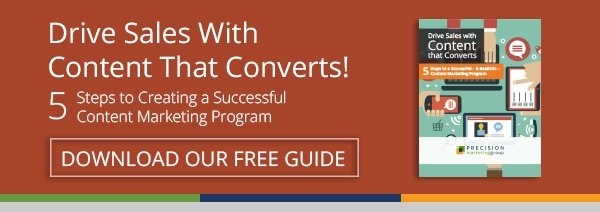I read Dr. Robert Cialdini’s Pre-Suasion book...
It’s about the psychology of persuasion—and boy is it freaky. It provides incredible insight on how you and I can be effectively persuaded, with examples of how it’s worked in the past. It’s a tool that can be used for good or evil. Today, I’m going to present some persuasive principles with tips on how to use them for good in marketing. The choice is yours.
Be Focal
What’s focal drives influence. People tend to respond favorably to those in focus.
Next time you have a client meeting, instead of having your usual phone call, set up a video call. If you happen to be meeting in person, sit directly in front of them. Holding a sales presentation? Place yourself in front of your audience. Don’t hide behind your PowerPoint.
If you don’t actually have access to your subject—say you’re writing an email or a content offer—then “see” them in the form of a buyer persona, a picture on your wall, or hang out where they hang out. Getting visual access to your target audience is vital and can make all the difference.
In the book, Cialdini recalls comparing the writing done in his university office and in a coffee shop. Noting that the first sentence of his best seller book Influence went from “My home discipline, experimental social psychology, has as its domain the study of everyday human behavior” to “I can admit freely now, all my life I’ve been a patsy.” Writing in the coffee shop subliminally put him in front of his audience and it was reflected in his writing.
Choose Your Words Wisely
This goes beyond being professional in email and in conversation with clients. Being careful with your word choice can effectively prime your subject to make a certain decision. For example, people love hearing about themselves, so use it to drive attention. Use “you” pronouns at the beginning of statements. People also interpret claims that are difficult to read as less true – so be simple and straightforward in your writing. For a company in a jargon-heavy industry, Capital One does an amazing job of keeping it simple. A couple more examples:
Avoid negative associations.
- Instead of using “cost” and “price,” use “purchase” or “investment.”
- Instead of saying “bullet points” which convey violence, use “topics.”
Use metaphors as a Call-to-Action.
- Saying that crime is a monster makes people want to trap it and jail it. Saying that crime is a virus makes people want to treat it.
Use our need for cognitive closure.
- People feel uneasy with an unfinished task. If you want to keep someone interested in what you’re saying, leave them wanting more.
Or don’t choose words at all.
- Opt for images over words. They are more effective.
Persuade for Action
One of the most important takeaways is that you can effectively prep your audience to take a certain action (hence the book’s title Pre-suasion). Here are a few ways you can do that:
- Want people to buy into your solution? First present the scary truth. It increases the likelihood that people will take the solution.
- Want someone to be a part of a larger group of people? Create a sense of urgency. People who feel this kind of pressure are more likely to want to join a group.
- Want someone to act as an individual? Prep them with something romantic. Romantic-focused people are more likely to act as individuals.
- Want to stand out against competitors? Instead of comparing yourself against one competitor, compare yourself against three that all have a similar feature (from which yours is different). You’ll stand out.
- Want someone to be more likely to do something for you? First give them a meaningful, unexpected and customized gift.
- Want someone to like you? Show people that you genuinely like them so that they like you. Give them compliments and share commonalities with them.
- Want someone to trust you? Use social proof over monetary deals. Social proof reduces perceptions of uncertainty and risk; a Buy One, Get One offer doesn’t.
Intrigued? See how these tactics (and more) can help you in advertising. Looking to really dive in? Read the book! Want to talk about it? Shoot Send me an email (see what I did there?).




